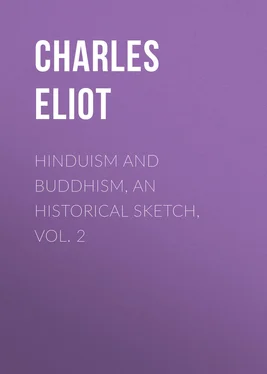Charles Eliot - Hinduism and Buddhism, An Historical Sketch, Vol. 2
Здесь есть возможность читать онлайн «Charles Eliot - Hinduism and Buddhism, An Historical Sketch, Vol. 2» — ознакомительный отрывок электронной книги совершенно бесплатно, а после прочтения отрывка купить полную версию. В некоторых случаях можно слушать аудио, скачать через торрент в формате fb2 и присутствует краткое содержание. Жанр: foreign_religion, Философия, Религиозная литература, foreign_psychology, foreign_antique, foreign_prose, на английском языке. Описание произведения, (предисловие) а так же отзывы посетителей доступны на портале библиотеки ЛибКат.
- Название:Hinduism and Buddhism, An Historical Sketch, Vol. 2
- Автор:
- Жанр:
- Год:неизвестен
- ISBN:нет данных
- Рейтинг книги:4 / 5. Голосов: 1
-
Избранное:Добавить в избранное
- Отзывы:
-
Ваша оценка:
- 80
- 1
- 2
- 3
- 4
- 5
Hinduism and Buddhism, An Historical Sketch, Vol. 2: краткое содержание, описание и аннотация
Предлагаем к чтению аннотацию, описание, краткое содержание или предисловие (зависит от того, что написал сам автор книги «Hinduism and Buddhism, An Historical Sketch, Vol. 2»). Если вы не нашли необходимую информацию о книге — напишите в комментариях, мы постараемся отыскать её.
Hinduism and Buddhism, An Historical Sketch, Vol. 2 — читать онлайн ознакомительный отрывок
Ниже представлен текст книги, разбитый по страницам. Система сохранения места последней прочитанной страницы, позволяет с удобством читать онлайн бесплатно книгу «Hinduism and Buddhism, An Historical Sketch, Vol. 2», без необходимости каждый раз заново искать на чём Вы остановились. Поставьте закладку, и сможете в любой момент перейти на страницу, на которой закончили чтение.
Интервал:
Закладка:
The Tibetan Lama Târanâtha who completed his History of Indian Buddhism 163 163 Translated by Schiefner, 1869. Târanâtha informs us (p. 281) that his chief authorities were the history of Kshemendrabhadra, the Buddhapurâna of Indradatta and Bhaṭaghaṭî's history of the succession of the Âcâryas.
in 1608 is a less satisfactory authority. He merits attention but also scepticism and caution. His work is a compilation but is not to be despised on that ground, for the Tibetan translations of Sanskrit works offer a rich mine of information about the history of the Mahayana. Unfortunately few of these works take the historical point of view and Târanâtha's own method is as uncritical as his materials. Dire confusion prevails as to chronology and even as to names, 164 164 The Tibetans generally translate instead of transliterating Indian names. It is as if an English history of Greece were to speak of Leader of the People instead of Agesilaus.
so that the work is almost useless as a connected account, though it contains many interesting details.
Two epochs are of special importance for the development of later Indian Buddhism, that of Kanishka and that of Vasubandhu and his brother Asanga. The reader may expect me to discuss at length the date of Kanishka's accession, but I do not propose to do so for it may be hoped that in the next few years archaeological research in India or Central Asia will fix the chronology of the Kushans and meanwhile it is waste of time to argue about probabilities or at any rate it can be done profitably only in special articles. At present the majority of scholars place his accession at about 78 A.D., others put it back to 58 B.C. and arrange the Kushan kings in a different order, 165 165 They place Kanishka, Vâsishka, Huvishka and Vasudeva before Kadphises I and Kadphises II.
while still others 166 166 E.g. Staël Holstein who also thinks that Kanishka's tribe should be called Kusha not Kushan. Vincent Smith in his latest work ( Oxford History of India , p. 130) gives 120 A.D. as the most probable date.
think that he did not come to the throne until the second century was well advanced. The evidence of art, particularly of numismatics, indicates that Kanishka reigned towards the end of his dynasty rather than at the beginning, but the use of Greek on his coins and his traditional connection with the beginnings of the Mahayana are arguments against a very late date. If the date 78 A.D. is accepted, the conversion of the Yüeh-chih to Buddhism and its diffusion in Central Asia cannot have been the work of Kanishka, for Buddhism began to reach China by land about the time of the Christian era. 167 167 My chief difficulty in accepting 78-123 A.D. as the reign of Kanishka is that the Chinese Annals record the doings of Pan Ch'ao between 73 and 102 in Central Asia, with which region Kanishka is believed to have had relations, and yet do not mention his name. This silence makes it primâ facie probable that he lived either before or after Pan Ch'ao's career. The catalogues of the Chinese Tripitaka state that An-Shih-Kao (148-170 A.D.) translated the Mârgabhûmi-sûtra of Sangharaksha, who was the chaplain of Kanishka. But this unfortunately proves nothing except that Kanishka cannot have been very late. The work is not a scripture for whose recognition some lapse of time must be postulated. An-Shih-Kao, who came from the west, may very well have translated a recent and popular treatise.
There is however no reason to assume that they were his work. Kanishka, like Constantine, probably favoured a winning cause, and Buddhism may have been gradually making its way among the Kushans and their neighbours for a couple of centuries before his time. In any case, however important his reign may have been for the Buddhist Church, I do not think that the history of the Mahayana should be made to depend on his date. Chinese translations, supported by other evidence, indicate that the Mahayanist movement had begun about the time of our era. If it is proved that Kanishka lived considerably later, we should not argue that Mahayanism is later than was supposed but rather that his relation towards it has been misunderstood. 168 168 In this connection we may remember Târanâtha's statement that Kanishka's Council put an end to dissentions which had lasted about a century. But he also states that it was after the Council that Mahayanist texts began to appear. If Kanishka flourished about 50 A.D. this would fit in with Târanâtha's statements and what we know of the history of Buddhism.
The date of Vasubandhu has also been much discussed and scholars have generally placed him in the fourth or fifth century but Péri 169 169 B.E.F.E.O. 1911, 339-390. Satiśchandra Vidyâbhûshana arrived at the same conclusion in J.A.S.B. 1905, p. 227.
appears to have proved that he lived from about 280 to 360 A.D. and I shall adopt this view. This chronology makes a reasonable setting for the development of Buddhism. If Kanishka reigned from about 78 to 123 A.D. or even later, there is no difficulty in supposing that Aśvaghosha flourished in his reign and was followed by Nâgârjuna. The collapse of the Kushan Empire was probably accompanied by raids from Iranian tribes, for Persian influence appears to have been strong in India during the confused interval between the Kushans and Guptas (225-320). The latter inaugurated the revival of Hinduism but still showed favour to individual Buddhists, and we know from Fa-Hsien that Buddhism was fairly flourishing during his visit to India (399-415). There is nothing improbable in supposing that Vasubandhu, who is stated to have lived at Court, was patronized by the early Guptas. The blank in Buddhist history which follows his career can be explained first by the progress of Hinduism at the expense of Buddhism and secondly by the invasions of the Huns. The Chinese pilgrim Sung-Yün has left us an account of India in this distressful period and for the seventh century the works of Hsüan Chuang and I-Ching give copious information.
In investigating the beginnings of the Mahayana we may start from the epoch of Asoka, who is regarded by tradition as the patron and consolidator of the Hinayanist Church. And the tradition seems on the whole correct: the united evidence of texts and inscriptions goes to show that the Buddhists of Asoka's time held the chief doctrines subsequently professed by the Sinhalese Church and did not hold the other set of doctrines known as Mahayanist. That these latter are posterior in time is practically admitted by the books that teach them, for they are constantly described as the crown and completion of a progressive revelation. Thus the Lotus 170 170 Chap. IV.
illustrates the evolution of doctrine by a story which curiously resembles the parable of the prodigal son except that the returned penitent does not recognize his father, who proceeds to reveal gradually his name and position, keeping back the full truth to the last. Similarly it is held in the Far East that there were five periods in Śâkyamuni's teaching which after passing through the stage of the Hinayana culminated in the Prajñâ-pâramitâ and Amitâbha sutras shortly before his death. Such statements admit the historical priority of the Hinayana: it is rudimentary (that is early) truth which needs completion and expansion. Many critics demur to the assumption that primitive Buddhism was a system of ethics purged of superstition and mythology. And in a way they are right. Could we get hold of a primitive Buddhist, we should probably find that miracles, magic, and superhuman beings played a large part in his mind and that the Buddha did not appear to him as what we call a human teacher. In that sense the germs of the Mahayana existed in the life-time of Gotama. But the difference between early and later Buddhism lies in this, that the deities who surround the Buddha in the Pali Pitakas are mere accessories: his teaching would not be affected if they were all removed. But the Bodhisattvas in the Lotus or the Sutra of the Happy Land have a doctrinal significance.
Интервал:
Закладка:
Похожие книги на «Hinduism and Buddhism, An Historical Sketch, Vol. 2»
Представляем Вашему вниманию похожие книги на «Hinduism and Buddhism, An Historical Sketch, Vol. 2» списком для выбора. Мы отобрали схожую по названию и смыслу литературу в надежде предоставить читателям больше вариантов отыскать новые, интересные, ещё непрочитанные произведения.
Обсуждение, отзывы о книге «Hinduism and Buddhism, An Historical Sketch, Vol. 2» и просто собственные мнения читателей. Оставьте ваши комментарии, напишите, что Вы думаете о произведении, его смысле или главных героях. Укажите что конкретно понравилось, а что нет, и почему Вы так считаете.












